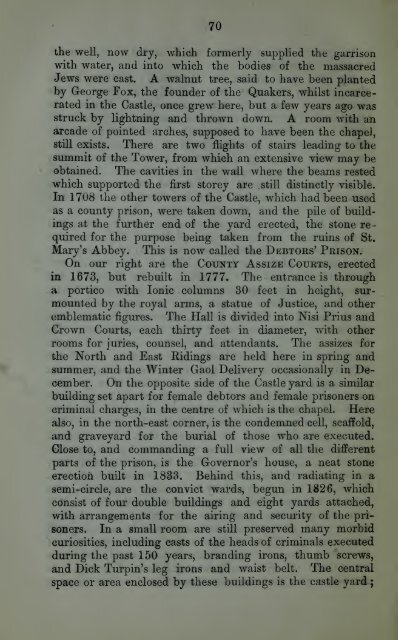practicalguideto00unse_0
You also want an ePaper? Increase the reach of your titles
YUMPU automatically turns print PDFs into web optimized ePapers that Google loves.
70<br />
the well, now dry, which formerly supplied the garrison<br />
with water, and into which the bodies of the massacred<br />
Jews were cast. A walnut tree, said to have been planted<br />
by George Fox, the founder of the Quakers, whilst incarcerated<br />
in the Castle, once grew here, but a few years ago was<br />
struck by lightning and thrown down. A room with an<br />
arcade of pointed arches, supposed to have been the chapel,<br />
still exists. There are two flights of stairs leading to the<br />
summit of the Tower, from which an extensive view may be<br />
obtained. The cavities in the wall where the beams rested<br />
which supported the first storey are still distinctly visible.<br />
In 1 708 the other towers of the Castle, which had been used<br />
as a county prison, were taken down, and the pile of buildings<br />
at the further end of the yard erected, the stone required<br />
for the purpose being taken from the ruins of St.<br />
Mary's Abbey. This is now called the Dkbtors' Prison.<br />
On our right are the County Assize Courts, erected<br />
in 1673, but rebuilt in 1777. The entrance is through<br />
a portico with Ionic columns 30 feet in height, surmounted<br />
by the royal arms, a statue of Justice, and other<br />
emblematic figures. The Hall is divided into Nisi Prius and<br />
Crown Courts, each thirty feet in diameter, with other<br />
rooms for juries, counsel, and attendants. The assizes for<br />
the North and East Ridings are held here in spring and<br />
summer, and the Winter Gaol Delivery occasionally in December.<br />
On the opposite side of the Castle yard is a similar<br />
building set apart for female debtors and female prisoners on<br />
criminal charges, in the centre of which is the chapel. Here<br />
also, in the north-east corner, is the condemned cell, scaffold,<br />
and graveyard for the burial of those who are executed.<br />
Close to, and commanding a full view of all the different<br />
parts of the prison, is the Governor's house, a neat stone<br />
erection built in 1833. Behind this, and radiating in a<br />
semi-circle, are the convict wards, begun in 1826, which<br />
consist of four double buildings and eight yards attached,<br />
with arrangements for the airing and secuiity of the prisoners.<br />
In a small room are still preserved many morbid<br />
curiosities, including casts of the heads of criminals executed<br />
during the past 150 years, branding irons, thumb screws,<br />
and Dick Turpin's leg irons and waist belt. The central<br />
space or area enclosed by these buildings is the castle yard















